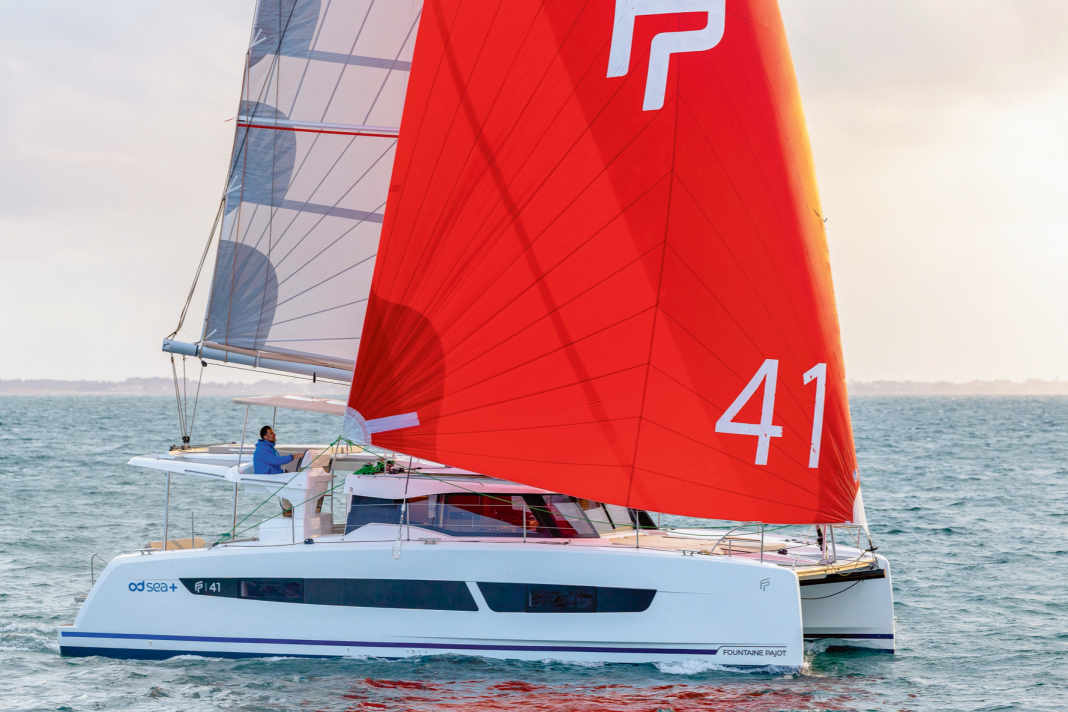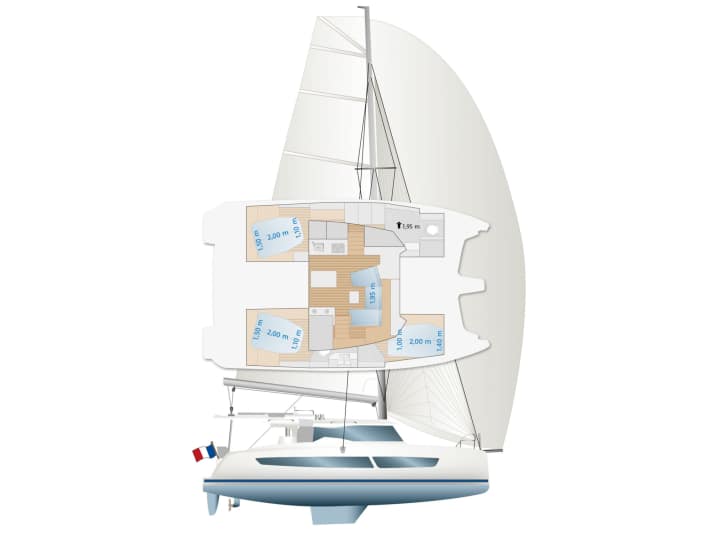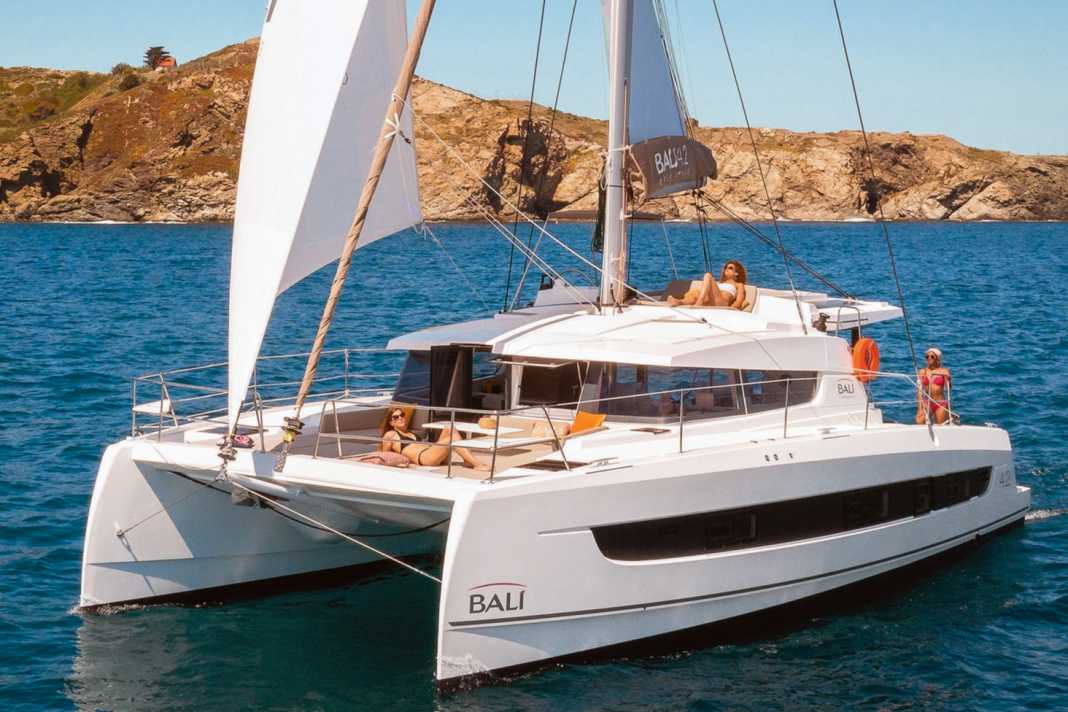





The new twin-hull aircraft, which still goes by the project name New 41, is intended to be much more than just a modification of the smallest types to date, the Astrea 42 or the Isla 40, of which a total of around 800 units were sold (a huge success).
The manufacturer, which was founded in 1976 in the La Rochelle area and became the second-largest shipyard group after Beneteau following the takeover of Dufour in 2018, is primarily operating with the new cat in the neighbourhood of comparable products from Lagoon, Bali and Leopard. The size is attractive for all shipyards, as it is popular with owners and charterers alike.
More from the shipyard:
And the format already offers what also characterises larger cats: four cabins, a deckhouse, a large cockpit, a lounge on the roof and one on the foredeck. This would be the version for the maximum number of people, the charter market primarily or large families. The typical owner's version leaves the starboard hull to the guests with two cabins with a shared narrow bathroom including a separate shower and makes the port hull, which can be separated from the saloon by a sliding door, available to the owners. They will then find an identical aft cabin, which has been designed to be open to the rest of the hull, the centre of which is fitted out with an office and a walk-in cupboard with various lockers and drawers. The designers have utilised the foredeck for a large separate shower, a washbasin and storage space, with a separate toilet room installed in front with space for a washing machine: somewhat strangely, there are neither windows nor hatches.
Plenty of space
In both aft cabins, the double berths are positioned slightly diagonally. This is intended to make better use of the space, improve access to the cushions and optimise the width of the sleeping area. With a width of 1.50 metres and a length of 2.00 metres, the two aft berths are moderately wide. The cushions in the foredeck are slightly narrower at 1.40 metres wide, just like French beds. The New 41 is comfortable in terms of headroom and storage space. Both are more than adequate. The many large windows in the cabins, some of which are equipped with smaller hinged windows and ensure good ventilation in combination with deck hatches, are also a success. This is an important point, as cats are mainly used in warm, if not tropical, waters.
In addition to the main cabins, there are two utility rooms in the bows, which are large enough to accommodate berths for the skipper and crew or additional children. However, these rooms must be accessed from above via separate hatches.
Measurement results of the Fountaine Pajot New 41



As is typical of catamarans, there is plenty of space outside. There is room for as many people at the fixed cockpit table as in the berths - up to eight. There is also a wide sofa and two chaise longues. As well as other amenities: There is a large plancha grill, an outdoor refrigerator and an electrically lowerable platform (maximum load 150 kilograms, surcharge 24,000 euros) for the dinghy.
Open design in the deckhouse
Also typical of twin-hull boats, the cockpit merges seamlessly into the deckhouse. The sliding door is over two metres wide. The passageway and the interior are parcelled out by a galley block, which extends the galley with work surface and storage space. The longitudinally orientated deck galley has a fixed (non-cardanic) three-burner hob, an oven and a sink. A refrigerator and a freezer compartment, both in drawers, are located on the other side of the galley block.
The deckhouse houses a second seating area with a small coffee table or optionally a larger piece of furniture, but there is no navigation area or even a second sheltered helm position. A large hinged window at the front ensures good ventilation at the anchorage and serves as a pass-through for drinks and food to the crew on the sun lounger on the foredeck. Like the roof lounge, it measures just under four square metres. Below this are two large storage spaces, some of which are used by the generator and tanks. Code Zero or gennaker can be stored there close to where they are used.
Steering and sail handling are separate from each other
The cockpit is permanently covered with a fixed GRP bimini. The traveller and a sunbathing area are installed on the structure. The entire cockpit can be transformed into a winter garden with side awnings - a cake stand XXL, so to speak.
The helm and manoeuvring station is housed in a cut-out in the roof, slightly raised in relation to the deck. The helmsman sits or lounges on a bench with side rests, an ideal place to enjoy the trip as a couple or to relax alone on longer journeys. The wheel can be reached directly from the cockpit via a few steps or from the outside via the stern. The traveller, which is particularly important on catamarans, the sheets and halyards run on three 46 mm winches from Harken. The special feature: The drums are operated while standing in front of the helm, which is the more ergonomically favourable position, but also separates the two functions of steering and sail handling. Clean one-handed operation therefore requires an autopilot. This in turn can be easily operated from the winches.
The cockpit is the actual living space and can be transformed into an XXL cake stand with canvas panels.
The wheel measures 70 centimetres in diameter and has to be moved a full 2.5 revolutions to move the two blades from stop to stop. The transmission is hydraulic - after all, the commands have to be transmitted from above deck to below and quite far aft on both sides - and works with correspondingly little communication.
Doldrums prevent test strike
Unfortunately, it was not possible to test how the system behaves in windy conditions. During the test off La Rochelle, there was an atypical calm, which even stuck the Imoca "Maitre CoQ", which was training in our neighbourhood, on the water. This means that only our own experience and speed forecasts can be used to assess performance.
Comparable predecessor models managed between four and five knots in an average wind speed of eight knots. These are figures that the Berret-Racoupeau design office confirms for the new 41. At a true wind speed of 16 knots, the French, who also work for Hanseyachts, predict eight knots at a tacking angle of 100 degrees, and they predict double-digit values at a wind angle of around 120 degrees. The shipyard also sees an advantage of the design in the longer keels, which would ensure better performance.
All realistic. But not proven. In this respect, a test drive is recommended. This is easy to do: the dealer First Class Yachting has a 41 in Warnemünde, among other things, and is happy to welcome visitors.
Optional hybrid drive
What was good to try out, however: The optional hybrid drive od sea +. This involves two pod drives that are powered by lithium-iron batteries. These, in turn, can be recharged on the move by means of hydrogen generation via rotating propellers, which are large and have three blades; however, the process also costs around one knot of speed. Further charging options are provided by solar panels, which can be installed on the large catamaran in almost excessive quantities: on the cabin roof, the bimini and in place of the trampolines on the foredeck. 2300 watts (peak) are feasible here. And even more reliable: a generator kicks in when the battery charge reaches 50 per cent. The electric drive means less noise, fewer emissions and less vibration.
The optional electric drive is powered by solar cells, recuperation, wind power and an efficient generator.
At a speed of five knots, the maximum noise level in the two aft cabins is 57 decibels (A). At a speed of seven knots, it is around 65 decibels (A) in the deckhouse, and the info display then speaks of an autonomy of at least five hours until one of the power suppliers kicks in.
A nice side effect of the electric motors: The best motor sailing: We create the apparent wind ourselves by machine and with pleasantly low noise levels. That works brilliantly.
Convincing despite minor flaws typical of large series production
The system clearly comes at a high price. The fun costs a good 170,000 euros. The alternative is two 20 hp units from Yanmar. Like the electric whirligigs, these are located in completely sealed-off engine chambers that are easily accessible from above and also house the other technology such as water pumps, quadrants and hydraulics. That's great, because the drives are thermally and exhaust-wise separated from the interior.
Whether electric or thermal: the propellers work in front of the rudder blades, which are thus well supplied with air, but this is not necessary as the catamaran is steered in the harbour via the engines and not via the blades.
The boat is also characterised by clean installations, easy access to components and easy access to various stations in the bilge. But its origins in large-scale production cannot be concealed either: There are sometimes unsealed edges of hatch covers, laminate that has not been painted over and some coarser or heterogeneous gap dimensions. Things that are not exclusive to the New 41.
Prices of the Fountaine Pajot New 41
The positive side of the New 41 is much stronger: successful predecessors whose DNA has been continued in the latest addition to the Fountaine Pajot family. More volume and space, more comfort on and below deck. Improvements in the details. There is a lot to be said in favour of the New 41, including the price: the New 41 starts at around 489,000 euros.
- Base price ex shipyard: 481.236 €
- Price ready to sail: 483.122 €
- Comfort price: 521.909 €
- Guarantee/against osmosis: 5/10 years
As of 2025, as the prices shown are defined, you will find here!
That's a lot of money, but it compares favourably: the Bali 4.2 costs 53,000 euros more, while a Lagoon 42 or the Leopard 42 are only available for 594,000 and 630,000 euros respectively.
In combination with its other good qualities, this makes Fountaines Pajot's new model a very attractive overall package, a boat that will go its way.
YACHT rating of the Fountaine Pajot New 41
The New 41 is comfortable, mature, solid and looks much bigger than a twelve-metre cat. The basic price is very competitive, but then there are still a few items missing.
Design and concept
Successful further development
Voluminous forward cabins
Proven drive alternative
Sailing performance and trim
Ergonomics on the winches
Successful steering position
Low-communication wheel hydraulics
Living and finishing quality
Lots of comfort and storage space
Clean installations
Room and area layout
Typical large series defects
Equipment and technology
Various useful options
High-quality components
The Fountaine Pajot New 41 in detail

Technical data of the Fountaine Pajot New 41
- Design engineer: Berret-Racoupeau
- CE design category: A
- Torso length: 12,10 m
- Total length: 12,10 m
- Waterline length: 12,10 m
- Width: 6,91 m
- Depth: 1,35 m
- Mast height above WL: 17,05 m
- Theoretical torso speed: 8.44 kn
- Weight: 12,7 t
- Ballast/proportion: 0,0 t/0 %
- Mainsail: 65,0 m²
- Furling genoa: 35,0 m²
- Machine (Yan.): 2 x 15 kW/20 hp
- E-drive: 2 x 25 kW
- Batteries: 2 x 21 kWh
- Fuel tank: 350 l
- Fresh water tanks: 2 x 300 litres
Hull and deck construction
The hull is produced using a vacuum infusion process using vinyl ester resins. The deck is manufactured using the RTM injection process in a closed double mould. Both methods stand for the desired and controlled resin content, a homogeneous laminate and low weight.
Power generation
Solar cells totalling 2300 Wp can be installed on the roof and foredeck. The optional electric drive is designed for recuperation. There is also enough space for two wind turbines.
New keels
The fixed lateral stubs are now longer and deeper and should therefore deliver better performance.
Shipyard
Fountaine Pajot, F-17290 Aigrefeuille; fountaine-pajot.com
Distribution
Dealer network
The competition is fierce and French dominated






